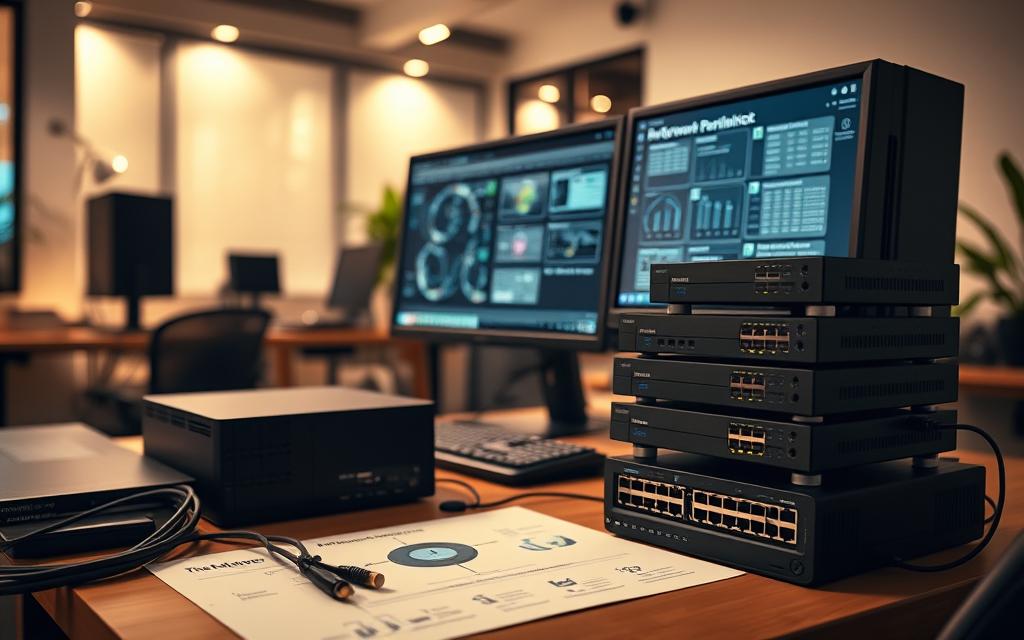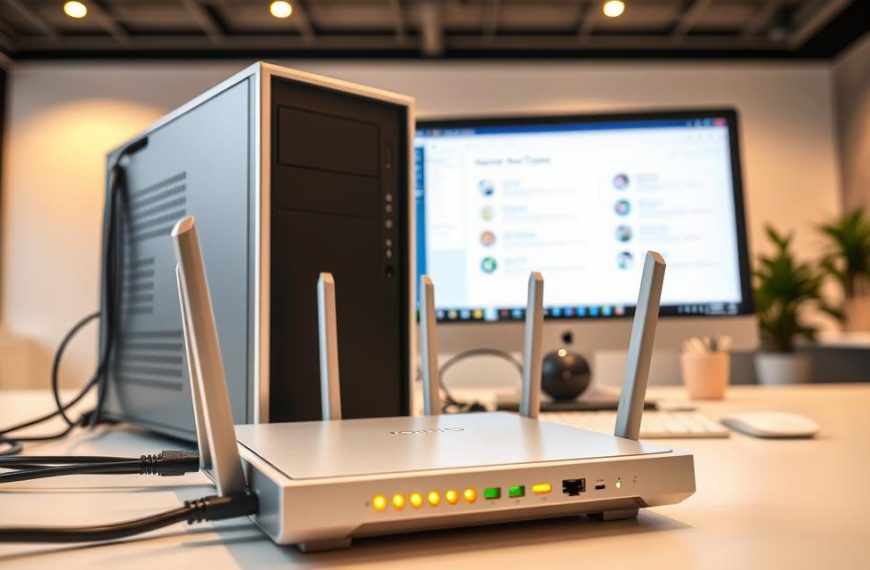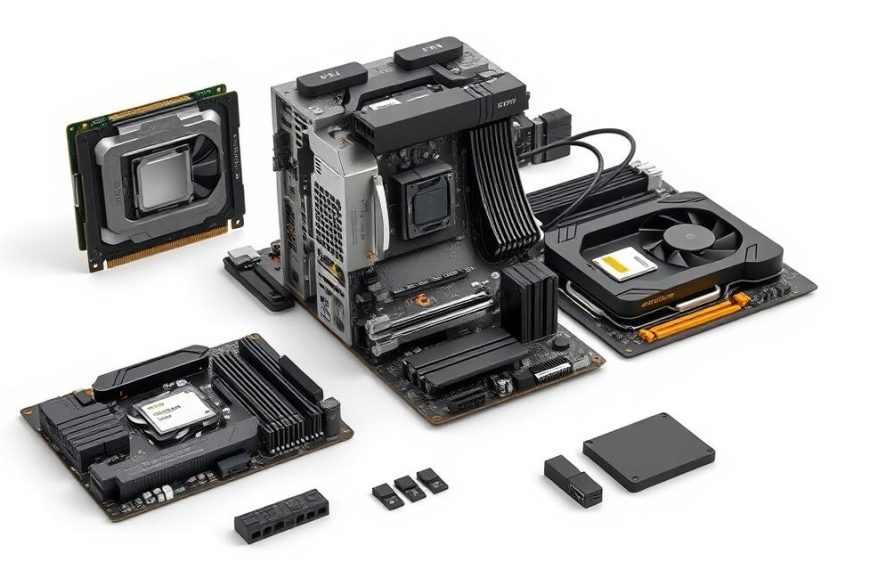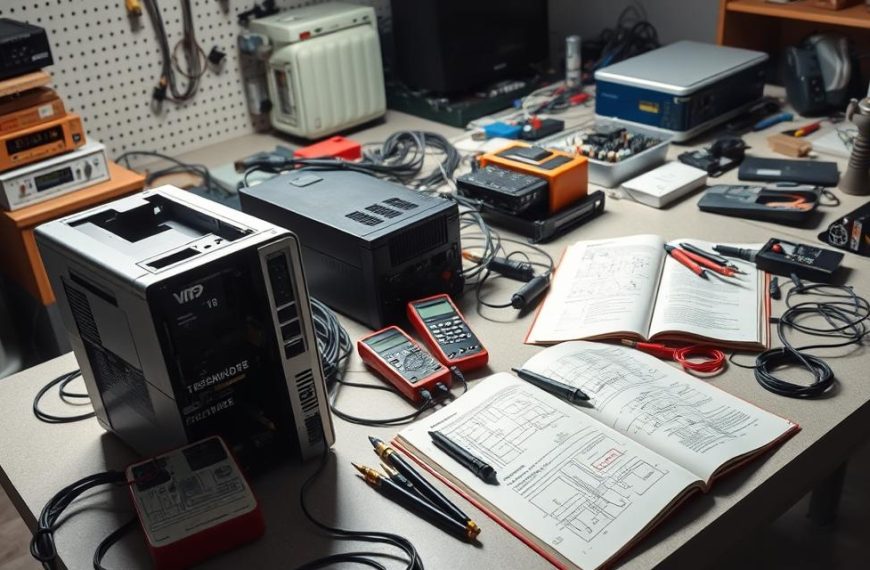A robust computer network is vital for modern businesses and home offices. Small businesses need well-planned network installations to connect multiple devices efficiently. This guide starts with understanding your specific connectivity needs.
Networks range from simple setups connecting two devices to complex systems supporting over 20. Businesses must consider their device requirements when designing their network setup.
A reliable network is crucial for smooth operations in most organisations. About 70% of businesses rely on well-structured networks for daily productivity. The right topology and hardware can greatly improve network performance.
Modern networks must support various smart devices like smartphones and WiFi printers. Professional network engineers can optimise your infrastructure within budget while ensuring top-notch connectivity.
Selecting the right network type requires careful thought about your needs. This guide will help you through the key steps of network installation123.
Understanding Network Types and Their Components
Computer networks have transformed digital communication. They offer various connection methods to suit different organisational needs. Network technologies are evolving rapidly4.
Networks are vital for seamless digital interactions. They range from small personal setups to extensive global systems. Each network type has unique features and capabilities5.
Exploring Wired Networks
Wired networks use physical cables for data transmission. They provide stable and secure connectivity4. These networks typically use Ethernet, coaxial, and fibre optic cables.
- Ethernet cables
- Coaxial cables
- Fiber optic cables
Wired networks offer several advantages:
- Higher transmission speeds
- Enhanced security
- Consistent performance
Wireless Network Innovations
Wireless networks transmit data using radio waves. They offer flexibility for modern digital environments4. These networks enable mobile connectivity across various devices and locations.
Key benefits of wireless networks include:
- Mobility
- Easy installation
- Scalability
Hybrid Networks: Integrated Solutions
Hybrid networks blend wired and wireless technologies. They deliver comprehensive connectivity solutions. These networks use the strengths of both connection types5.
By combining network types, businesses can boost performance. They can enhance security and create adaptable digital ecosystems. This approach offers versatile and robust communication infrastructures.
Essential Hardware Requirements for Network Setup
Selecting the right network hardware is crucial for building a robust computer network. Understanding key components helps create an efficient and reliable connection between devices6.
Network Adapters and Routers
Network adapters are vital for connectivity. Desktop computers often have built-in adapters, while laptops may need additional hardware7.
Routers are essential for managing network traffic and internet connectivity8. They come in various types and price ranges.
- Basic routers with four wired connections start at £70
- Advanced routers supporting up to 24 connections can cost £300
- Wi-Fi routers begin around £70
Cables and Additional Equipment
Ethernet cables are crucial for wired network connections. Cat 6 cables are ideal for high-speed data transfer and demanding tasks8.
- Wired networks can transfer data at speeds from 10 Mbps to 1000 Mbps
- Each device requires one Ethernet cable for connection
- Recommended cable type: 10/100/1000 Cat 6
Choosing the Right Hardware Configuration
Your network hardware choice depends on specific needs. Consider factors like network size, data transfer requirements, and budget6.
A typical home network setup costs between £100 and £300, including a modem and router6.
90% of businesses rely on computer networks for daily operations, making careful hardware selection crucial6.
Pro tip: Ensure all network components have similar ratings for optimal performance. The slowest element determines the network’s overall speed8.
How Do You Set Up a Computer Network
Setting up a computer network needs careful planning and systematic implementation. Most homes now have 3-5 internet-connected devices. A robust network setup process is crucial for modern households.
Understanding the basic components and following a structured approach is key. The process involves selecting the right equipment and configuring it properly.
Start by choosing the right equipment for your network. Most homes use broadband connections with gear from their Internet Service Provider. For best results, follow these steps:
- Choose appropriate network adapters
- Select a reliable router
- Determine connection type (wired or wireless)
- Configure network security settings
For wired networks, Gigabit Ethernet offers top performance with speeds up to 1,000 Mbps9. Wireless networks use 2.4 GHz and 5 GHz bands. Each band has different range and bandwidth features.
Pro tip: Use non-overlapping channels (1, 6, or 11) on 2.4 GHz bands to minimise interference and maximise network performance.
Security is vital in your network setup. Use Wi-Fi Protected Access 2 (WPA2) or WPA3 to guard against unauthorised access9. Create a strong Wi-Fi password with at least 12 characters.
Include uppercase, lowercase letters, and special characters in your password10. For families needing high-performance connectivity, 100 Mbps bandwidth is recommended10. This supports multiple simultaneous activities.
By following these steps, you’ll create a reliable, secure, and efficient home network. Your setup will meet the needs of modern digital households.
Network Security and Protection Measures
Safeguarding your computer network is vital in today’s digital world. Network security employs strong strategies to shield your digital setup from cyber threats11. Small businesses face high risks, with 60% suffering cyber attacks yearly11.
Proper security measures are key to prevent unauthorised access. They also protect sensitive data from prying eyes. Firewall setup is crucial for network security.
These digital barriers can cut unauthorised access risks by 85%11. Modern firewalls block malware and application-layer attacks effectively12. Many firms now use cloud network security solutions for better protection12.
Password protection is a core part of network defence. Human errors cause 95% of cybersecurity breaches11. Multi-factor authentication can slash data breach risks by 99.9%11.
The Zero Trust model suggests limiting user access to essential information12. This approach boosts overall network security by reducing weak points. Strong security measures can save businesses 30% on breach-related costs12.
Cyber threats keep evolving, so organisations must stay alert. Regular updates, encryption, and staff training are vital for robust network defence. These steps help create a solid shield against digital dangers.
FAQ
What is the difference between wired and wireless networks?
How do I choose the right network type for my home or small business?
What essential hardware do I need to set up a computer network?
How can I ensure my network is secure?
What type of Ethernet cable should I use?
How do I set up a wireless network?
Can I mix wired and wireless devices on the same network?
What are the potential challenges when setting up a network?
Source Links
- https://www.alwaysonit.com/blog/a-quick-guide-for-setting-up-a-computer-network-for-small-business
- https://www.linkedin.com/pulse/step-by-step-guide-successful-computer-network-ric-acevedo
- https://amorserv.com/insights/how-to-set-up-a-new-office-network-in-10-steps-a-step-by-step-guide
- https://www.ibm.com/think/topics/networking
- https://blog.netwrix.com/network-devices-explained
- https://www.eccentrix.ca/en/eccentrix-corner/setting-up-a-computer-network-a-comprehensive-configuration-guide/
- https://learn.microsoft.com/en-us/troubleshoot/windows-client/networking/set-up-your-small-business-network
- https://www.techdonut.co.uk/communications/networks/network-equipment-and-cables
- https://www.techtarget.com/searchnetworking/tip/Tips-for-setting-up-a-home-network
- https://www.devolo.global/guide/set-up-home-network
- https://www.bbc.co.uk/bitesize/guides/z6226yc/revision/1
- https://www.checkpoint.com/cyber-hub/network-security/what-is-network-security/















